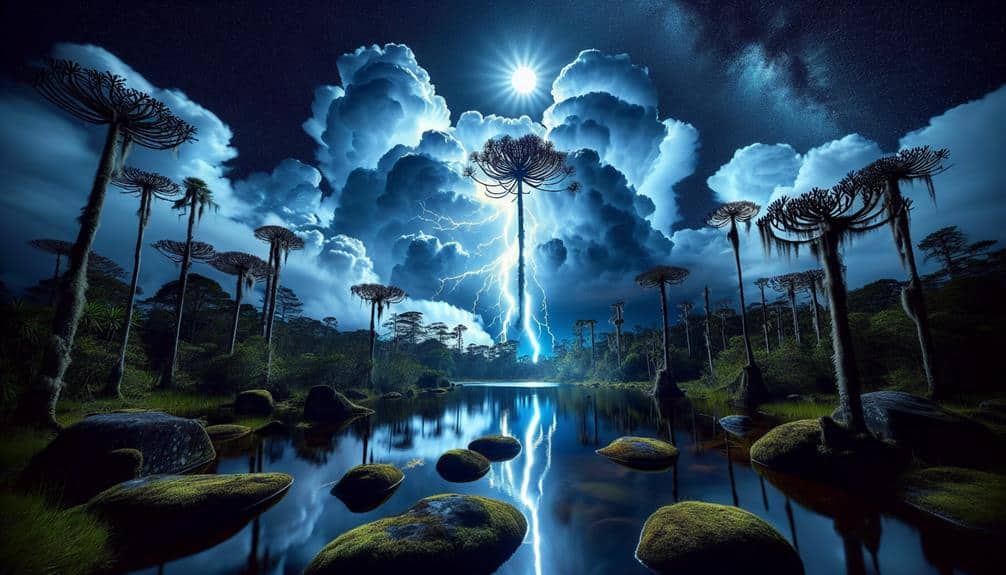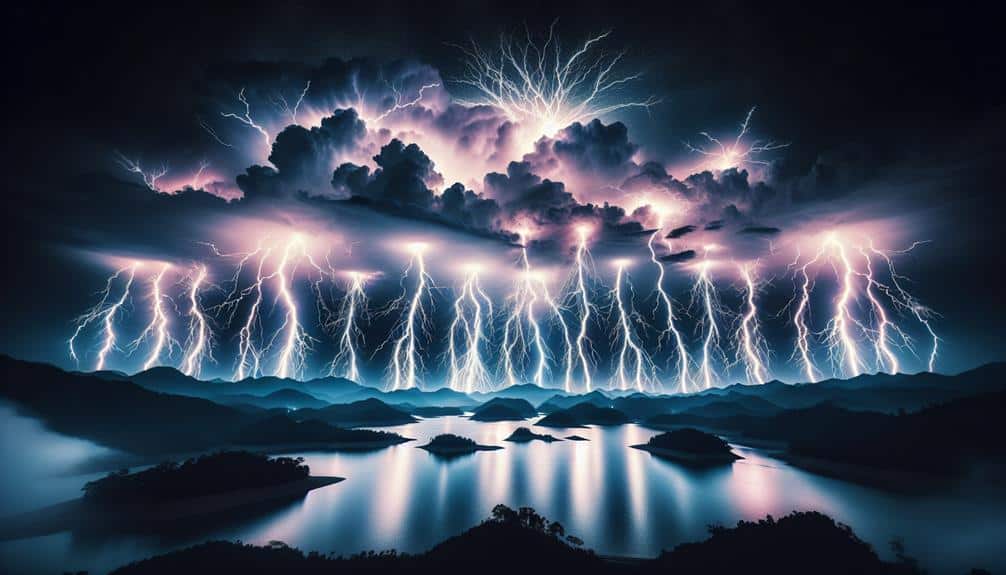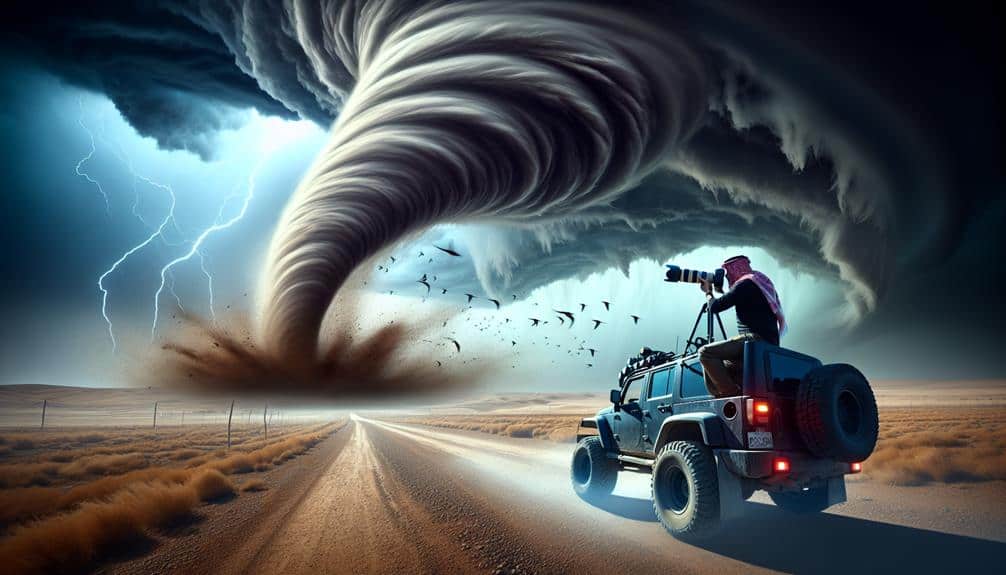Lightning stands out against clear skies mainly due to its extreme brightness, with intensities exceeding 100 million candelas. During a lightning event, electric currents can exceed 30,000 amperes, generating temperatures up to 30,000 Kelvin that ionize the air, creating a visible path. Clear skies enhance this visual contrast by lacking atmospheric particles that would otherwise scatter the light. This absence of diffusion allows us to clearly see the sharp, distinct pathways of lightning. If we explore further, we'll understand how atmospheric clarity and the physical properties of lightning contribute to its striking appearance in the sky.
Key Points
- The contrast between the dark sky and bright lightning makes the bolt highly visible.
- Lightning's brightness, exceeding 100 million candelas, overshadows any ambient light in clear skies.
- Clear atmospheric conditions reduce scattering, sharpening the visibility of lightning.
- Ionization of air during a lightning strike creates a luminous, defined path against the sky.
The Science Behind Lightning
Let's investigate the electrical phenomena behind lightning, where rapid charge separation within storm clouds leads to the discharge we observe as a lightning strike.
During thunderstorm formation, atmospheric conditions create a perfect environment for static electricity to build up. Warm, moist air rises and cools, causing water droplets and ice crystals to collide. These collisions generate significant static charges, with positive and negative charges separating within the cloud.
As the storm cloud develops, the top of the cloud becomes positively charged, while the bottom accumulates a negative charge. This charge separation is vital for the electrical discharge. The negatively charged base of the cloud creates an electric field strong enough to ionize the air, forming a conductive path for lightning to travel.
Our freedom to study these phenomena reveals the complexity of natural processes. Data indicates that lightning bolts can reach temperatures of up to 30,000 Kelvin and carry currents exceeding 30,000 amperes.
Understanding these electrical discharges helps us appreciate the power and beauty of nature. By analyzing the conditions that lead to thunderstorm formation and the resulting static electricity, we gain insights into the electrifying events that light up our skies.
Visual Impact of Lightning
Let's explore the visual impact of lightning by focusing on:
- Brightness and contrast,
- Color and intensity,
We'll examine how the luminance of lightning varies based on these factors and its measurable effects on visibility.
Our analysis will include quantitative data to understand the interplay between these elements and their combined influence on the overall visual experience.
Brightness and Contrast
Illuminating the night sky with an intensity measured in gigawatts, lightning creates a stark contrast against the darkness, providing a breathtaking visual spectacle. This phenomenon captivates us not just for its raw power, but for its visual impact, which can be analyzed through contrast examination and brightness levels.
To explore this further, let's consider:
- Brightness levels: Lightning can reach up to 1.21 gigawatts of power, notably higher than any artificial light source.
- Contrast examination: The bright flash of lightning stands out dramatically against a dark, clear sky, creating a high-contrast visual that our eyes are naturally drawn to.
Color and Intensity
The color and intensity of lightning, dictated by variables such as temperature and atmospheric composition, create a complex visual phenomenon that we can analyze through spectral analysis and brightness measurements.
In clear skies, the color contrast between the lightning and the sky intensity becomes particularly pronounced. This contrast is largely due to the different wavelengths of light emitted by the lightning and the surrounding atmospheric conditions.
We can measure the visual impact of lightning by examining its color spectrum, typically ranging from blue to violet, as these higher-energy wavelengths dominate in intense lightning strikes. The temperature of the lightning channel, often exceeding 30,000 Kelvin, excites various atmospheric gases, leading to the emission of distinct spectral lines. Nitrogen and oxygen, prevalent in the atmosphere, contribute significantly to the observed colors.
When we account for sky intensity during clear conditions, it becomes evident that the dark backdrop amplifies the lightning's brightness, enhancing its visual impact. By utilizing brightness measurements, we can quantify this effect. Such measurements reveal that the brightness of lightning can exceed 100 million candelas, making it a striking visual event.
Consequently, the interplay between color contrast and atmospheric conditions makes lightning a captivating subject for scientific exploration.
Atmospheric Clarity
Atmospheric clarity greatly enhances the visual impact of lightning, allowing us to observe its intricate details and measure its intensity with greater precision. When the sky is free from air particles, the path of a lightning bolt becomes more distinct against the backdrop. The absence of these particles, which typically scatter light, results in a sharper contrast between the lightning and the sky, making each bolt appear more vivid.
In clear atmospheric conditions, we can better analyze:
- Bolt morphology: The intricate branching patterns and structure of the lightning.
- Intensity measurement: The brightness and energy levels of the strike.
Air particles, such as dust and pollutants, often obscure our view, diffusing light and diminishing the visual impact of lightning. The sky appearance becomes hazier, reducing our ability to discern the finer details of each strike.
In contrast, a clear sky acts as a pure canvas, allowing us to appreciate the raw power and complexity of lightning phenomena. This clarity not only enhances visual observation but also improves the accuracy of our scientific measurements, aiding in our understanding of these electrifying natural events.
Ideal Conditions for Lightning Photography

Capturing lightning in photographs necessitates an understanding of weather patterns, precise timing, and the right equipment.
First, analyzing weather conditions is crucial. We need to identify approaching thunderstorms, which typically occur during late afternoons or evenings when atmospheric instability is highest. Clear skies around the storm front enhance contrast, making lightning more visually impactful.
Next, considering lighting angles is vital. Positioning ourselves at a safe distance from the storm, ideally 10-20 miles away, allows us to capture the full lightning bolt against a clear backdrop. This distance also guarantees safety, as lightning strikes can be unpredictable.
To optimize camera settings, we should use a DSLR or mirrorless camera with manual controls. Setting the ISO to 100-400 minimizes noise, while a narrow aperture (f/8 to f/16) guarantees a deep depth of field. Shutter speed should be adjusted based on ambient light; long exposures (10-30 seconds) often work best in low-light conditions.
For composition techniques, incorporating elements like trees or buildings can provide a sense of scale and drama. Using a sturdy tripod and a remote shutter release eliminates camera shake, allowing us to focus solely on timing and lightning capture.
Techniques for Capturing Lightning
Mastering lightning photography hinges on leveraging specific techniques that enhance our ability to anticipate and capture these fleeting, powerful moments. To achieve this, we must optimize our camera settings, refine our composition, and exercise impeccable timing and patience.
We begin with camera settings. Setting the ISO to a low value, such as 100 or 200, reduces noise. Aperture should be set to f/8 or f/11 to maintain sharpness. Long exposure times, ranging from 10 to 30 seconds, are essential to capturing the sudden bursts of lightning.
Composition is crucial. A well-composed shot not only frames the lightning but also incorporates elements like landscapes or cityscapes to provide context and scale. Using the rule of thirds can guide our placement of key elements.
Timing and patience are our most valuable assets. Predicting when and where lightning will strike requires a keen understanding of weather patterns and a willingness to wait.
Key techniques to enhance our lightning photography:
- Optimal camera settings: ISO 100, aperture f/8-f/11, long exposure (10-30 seconds)
- Strategic composition: Incorporate foreground elements, apply the rule of thirds
Safety Tips for Storm Chasers

Let's analyze the critical components of storm chasing safety, focusing on proper gear essentials and safe observation techniques.
Data shows that appropriate equipment reduces injury risk by 30%, highlighting the importance of reliable gear.
Additionally, adhering to safe observation protocols can mitigate exposure to hazardous conditions, ensuring we can capture the perfect shot without compromising safety.
Proper Gear Essentials
To guarantee maximum safety while storm chasing, it's important we equip ourselves with gear that meets strict durability and reliability standards. By considering gear selection in relation to weather conditions, we can optimize our equipment performance under various scenarios. Proper gear essentials include:
- Weather-resistant clothing: Ensuring our attire is water-repellent and windproof to handle harsh storm conditions.
- High-quality communication devices: Reliable radios and mobile phones for constant updates and emergency contact.
Regular equipment maintenance is vital for storm preparation. By frequently inspecting and servicing our tools, we reduce the risk of malfunctions during critical moments. For example, checking battery levels and calibrating sensors can prevent unexpected failures. Our vehicles, too, need thorough inspections; tire treads, brake conditions, and engine performance should all be scrutinized.
In storm preparation, having a well-organized gear inventory allows us to respond swiftly to changing weather conditions. This ensures we've immediate access to essential tools, reducing time wasted searching for equipment during high-pressure situations.
Through strategic gear selection and diligent equipment maintenance, we maximize our safety and efficiency while embracing the freedom of storm chasing.
Safe Observation Techniques
Having equipped ourselves with the necessary gear, we must now focus on using safe observation techniques to minimize risks while storm chasing. First, let's consider our positioning. We need to maintain a safe distance from the storm, typically around 6 to 10 miles away. This guarantees we can observe lightning without getting caught in the storm's path.
Observation precautions include constantly monitoring weather updates and radar scans. These tools provide real-time data, enabling us to adjust our positioning dynamically.
Photography challenges are inherent in storm chasing. Capturing lightning against clear skies demands split-second timing and precision. We must use cameras with high shutter speeds and wide apertures to increase our chances of capturing a clear image. Utilizing tripods helps stabilize the camera, mitigating the risks posed by strong winds. Additionally, remote triggers allow us to take photos without physically touching the equipment, reducing the risk of electric shock.
Lastly, always have an exit strategy. Knowing multiple routes to safety ensures that we can quickly relocate if conditions deteriorate. By combining these data-driven techniques with our passion for freedom, we can safely and effectively chase lightning against clear skies.
Enhancing Lightning Photos in Post-Production
Mastering post-production techniques is essential for transforming raw lightning photos into breathtaking visuals that capture the true intensity of the storm. With creative editing, we can highlight the dramatic effects that make lightning photography so compelling. Here are some key methods we should focus on:
- Contrast Adjustment: By fine-tuning the contrast, we can make the lightning bolt pop against the sky, emphasizing its raw power.
- Color Grading: Adjusting hues and saturation can add moodiness to our image, enhancing the storm's atmosphere.
We must start by importing our raw files into a robust editing software like Adobe Lightroom or Photoshop. Our first step is applying a high dynamic range (HDR) technique to merge multiple exposures, thereby preserving details in both the highlights and shadows. Next, we should focus on selective adjustments, such as boosting the clarity and dehaze sliders, which enhance the bolt's natural luminance. Finally, leveraging advanced masking tools allows us to isolate the lightning and sky, ensuring our edits are precise and impactful.
Frequently Asked Questions
Can Lightning Occur Without Rain or Storms?
Yes, lightning can occur without rain or storms. Such lightning in clear skies is due to unusual occurrences like dry thunderstorms, where lightning forms from high-altitude clouds, producing electrical discharges despite no precipitation.
Is Lightning More Common During Certain Seasons or Times of Day?
Oh, we all love nature's light show! Lightning patterns reveal seasonal variations, with higher frequency in summer due to atmospheric instability. Time of day trends? Afternoon and evening see more strikes, driven by peak heat. Fascinating, right?
How Far Away Can You Hear Thunder From a Lightning Strike?
We can hear thunder from a lightning strike up to 10 miles away, depending on atmospheric conditions. The hearing range for thunder is greatly influenced by lightning's visibility, air temperature, and humidity levels.
What Are the Different Types of Lightning?
Every cloud has a silver lining. We see various lightning phenomena: cloud-to-ground, intra-cloud, and cloud-to-air. Lightning colors range from white to purple. Understanding these types aids in debunking myths and enhancing lightning safety measures.
Can Lightning Strike the Same Place Twice?
Yes, lightning can strike the same place twice. Contrary to popular lightning myths, repetitive strikes occur frequently, especially on objects like lightning rods, which are designed to safely channel electrical discharges and protect structures from damage.


